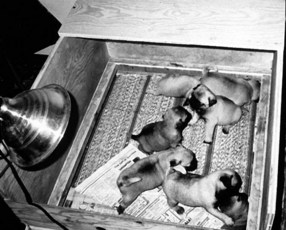CHAPTER 11 Neonatal Mortality
The primary chronologic benchmarks for neonatal survival generally are birth, the first 24 hours, the first week, and weaning. The neonatal mortality rate for each of these benchmarks decreases as the neonate progresses along the timeline; 75% of puppy deaths occur in the first 3 weeks of life, 50% of neonatal deaths happen in the first 3 days, and 65% in the first week. In some studies, stillbirth accounts for 50% of the losses (Table 11-1).
TABLE 11-1 Summary of 421 puppy deaths
| Age | Number (%) |
|---|---|
| Parturition (stillbirth) | 126 (29.9) |
| Days 0-3 (live birth) | 209 (49) |
| Days 4-28 | 71 (16.9) |
| Days 29-42 | 5 (1.2) |
| Days 42-45 (postweaning) | 10 (2.4) |
From Lawler DF: Neonatal and pediatric care of the puppy and kitten, Theriogenology 70(3):384-392, 2008.
The veterinarian may be presented with a dead neonate by a wide variety of owners. Sometimes, the breeder has significant financial interest in the litter and is seeking a specific diagnosis as a long-term herd health business solution. Other times, a new owner wants to know why the neonate has died; those cases in which a newly purchased pet is involved can carry an increased risk of litigation between the owner and breeder (the classic financial interest and who is paying for this scenario). Occasionally, owners let their dog/cat have one litter to show their children the miracle of life and were ill prepared for the miracle of death and desperately looking for a cause of death to answer their children’s questions. The extent that each of these owners is willing to pursue a diagnosis varies. Often, no answer is found. The local diagnostic laboratory can provide guidelines on sample preparation before submission; following guidelines can increase the probability of obtaining a specific diagnosis (see Chapter 29).
Owner Issues
A thorough history includes information on the experience and management approach of the owner. It is important to know if this was a planned breeding and if the owners have any pedigree information, since matings with high-inbreeding coefficients have smaller litter sizes and increased neonatal mortality. Was the owner present at the whelping or queening? Is there a mortality history of previous litters managed by the owner? Was this a planned breeding? Was the breeding timed so a known birthing date was available? Did the owner try to treat the dam or offspring; if so, with what medication or nutraceutical? How closely are the newborns monitored, are they out in the garage or is the owner sleeping next to the whelping box in the family room? A wide variety of questions about owners and their involvement in the breeding, delivery, and postbirthing management of the newborns can elicit important data in determining the cause of neonatal mortality. Box 11-1 lists common, relevant questions for owners.
Stud Issues
The impact of the stud is not generally considered by owners as a possible cause of neonatal mortality. However, owners often acquire a stud with no previous health or reproductive history. Additionally, they may use a male from some other facility, with a minimum of testing for preexisting diseases, which may affect his fertility and/or the health of the dam and offspring. The stud’s age, size, and health all contribute to neonatal losses. Questions that should be pursued relative to the stud are listed in Box 11-2.
Environmental Issues
Early, preweaning neonatal vulnerability is influenced most by the dam and the environment into which the neonates are born (Box 11-3).
Poor whelping or nesting box design can be a major source of neonatal mortality. If the box is too large, the chances for a neonate to get separated from the mother are increased. If the box is too small, the chances of neonates being stepped on or laid on is increased. Whelping or nesting boxes without “hog rails” (Figure 11-1) increase the probability of neonates being crushed against the wall by their mother. Additionally, the whelping box should be made of materials that are easily cleaned and disinfected and do not retain moisture.

Figure 11-1 Whelping box with “hog rails.”
(From Johnston SD, Root Kustritz MV, Olsen PNS: Canine and feline theriogenology, St Louis, 2001, Saunders/Elsevier.)
Proper environmental hygiene is paramount, since puppies and kittens have a variety of structural, metabolic, and immune conditions that although normal for their age, makes them more susceptible to infectious disease. Proper selection of disinfectants is important; however, care should be taken to keep these from becoming environmental toxins (Table 11-2). Neonates have very thin skin and transdermally absorb toxins more readily than adults. The owner should be particularly careful with cleaning agents such as pine oils and phenols. Overuse of bleach or other disinfectants or employing high concentrations of these products puts the neonates at risk. Few disinfectants work well in the face of organic debris, therefore proper cleaning should occur before disinfecting the area (Box 11-4).
| Disinfectant | Effective spectrum of activity |
|---|---|
| Phenolics | Most bacteria except spore formers, possibly some viruses |
| Alkalis | Most bacteria, some spore formers, some viruses |
| Chlorine | Wide bacterial spectrum, viruses and protozoa, little activity vs. spore formers† |
| Chloramine | Most bacteria |
| Quaternary ammonium | Most bacteria, some viruses† |
| Chlorhexidine | Most bacteria and fungi, poor on spore formers or viruses† |
| Hydrogen peroxide | Most bacteria, spore formers and virus |
* Use at manufacturer’s recommended concentration.
† Significantly decreased activity in organic material.



